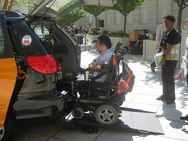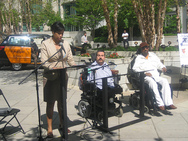Wheelchair-accessible cabs increase DC mobility

Photo courtesy of MWCOG
As of Thursday, DC’s residents and visitors with disabilities no longer have to struggle with unreliable Metro elevators or schedule MetroAccess rides 24 hours in advance. Instead, they can take a cab like anybody else.
On Thursday morning, MWCOG and the DC Taxi Commission launched rollDC, the District’s new accessible cab pilot program. Through a $1 million New Freedom grant from the Federal Transit Administration and a $200,000 match from DCTC, there are now 20 fully wheelchair-accessible Toyota Sienna minivans plying the streets of DC, 24 hours a day, 7 days a week. All you have to do is call Royal Cab or Yellow Cab of DC and request an accessible cab.
Though the Americans with Disabilities Act was passed two decades ago, taxi cabs were largely exempt from the legislation that required everything from subways to movie theaters to provide a minimum level of accessibility accommodation. While all taxi companies must accommodate those passengers with disabilities who are able to use a regular taxi, including allowing services animals, and requiring drivers to stow mobility devices like walkers and foldable wheelchairs for a customer, the ADA does not require any special accessibility features for all “sedan-type” vehicles.
In 1990, this may have made a significant impact, as the number of people with disabilities using standard, manual wheelchairs was relatively large. Over the past 20 years though, advances in various technologies have increased the availability and usability of powered wheelchairs, which, while improving mobility and independence of the people that use them, have ironically made taxi service less accessible.
As the ADA was written, taxi companies are not required to modify their vehicles to accommodate passengers in wheelchairs until the companies purchased or leased a van or an SUV for its fleet. Once a taxi operator’s fleet included at least one non-sedan vehicle, though, ADA requirements for full wheelchair accessibility kick in.
Unfortunately, this has provided a strong disincentive in many places for taxi companies to have any cabs that aren’t sedans, which has been the case in DC. This is where the New Freedom program helps. Under this FTA program, states and metro regions receive a designated amount of money each year to provide transportation service or accommodations “above and beyond” what the ADA requires.
Because the economics of the DC taxi market had not made having large minivan or SUV cabs financially attractive enough to also comply with ADA requirements for fully accessible services, MWCOG designated a portion of the Washington region’s New Freedom money to start the rollDC program.
Under rollDC, MWCOG purchased the modified Sienna vans and solicited two private cab companies, Yellow Cab of DC and Royal Cab, to own and maintain the vehicles. Because loading and unloading a passenger in a wheelchair takes longer than other passenger pick-ups, rollDC will also pay drivers an additional $2 per trip provided to customers in wheelchairs.
This new program has the potential to provide significant, two-fold impact on DC’s transportation system. First, it will greatly increase the flexibility and mobility option of the city’s residents and visitors who use wheelchairs. This is by far the most important outcome.
Less crucial to the human impact, but intriguing given Metro and DC’s current budget crises, rollDC increases the ability of MetroAccess to provide ADA complementary paratransit through contracts with private taxi providers instead of through its costly, standard scheduled service.
Many paratransit providers, inlucluding MetroAccess, already use taxis to provide some service, but frequently this is limited to ambulatory customers who have other types of disabilities. With the introduction of accessible taxi cabs, MetroAccess now has the option to provide rides for nearly any eligible customer through taxi service, either through a voucher program, or through direct contract.
A typical MetroAccess trip with raised-roof or cut-away van costs Metro around $40. Many trips within DC and its immediate surroundings could be easily provided by taxi for a cost savings per trip. Additionally, by instituting a voucher program, MetroAccess could potentially give customers more flexibility than the current 24-hour advance scheduling rules allow.
With only 20 vans on the street, the ability for MetroAccess to realize significant savings through taxi-provided paratransit is still relatively low, but ridership numbers from the test phase run over the last year, indicate that there will likely be demand for more vehicles. In March of this year the vans on the street provided 349 trips.
These new cabs don’t benefit people with disabilities alone. The presence of more large cabs increases the viability of group rides, as well as the ability to live in the city without a car, by making it easier to make shopping trips with bulky items. rollDC will improve mobility options for thousands of DC residents and visitors, disabilities or not. And that is an unequivocally good thing.

